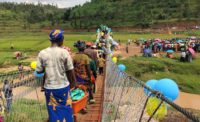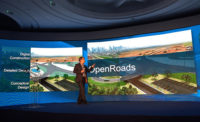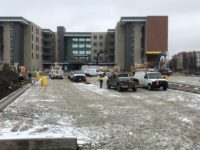Just my luck that the first international board meeting I attended for Bridges to Prosperity included the opening ceremonies of the Siquipampa pedestrian bridge at 11,500 ft in the Central Cordillera Tunari mountains of Bolivia. Attending involved a challenging descent down a dirt path with a 700-ft vertical drop—and the breath-gasping climb back out. The bridges are always remote but rarely so high.
The 600 village residents are periodically entirely cut off from their school and the outside world. What was a rippling stream on the June afternoon of my visit turns into a raging river during the rainy season from November to March.
Board members drove in two vans for four hours into the mountains from Cochabamba—a city of about 600,000 people in central Bolivia and also the name of one of Bolivia’s departments. We turned onto a bumpy dirt road that switchbacked into a valley, where the vans could cross the river, and back up the other side. When we finally pulled over, we could hear music from zampoña, reedy instruments played by villagers welcoming us far down in the valley. The new bridge was a speck at the bottom of the mountainside.
After a dusty climb, we were greeted with fruit drinks, more music and dancing. The opening ceremonies involved speeches and sprinkling our heads with confetti. To christen the bridge, pottery flasks filled with local moonshine were smashed on the deck! After joining the parade across the bridge and back again, we were served heaping plates of boiled new potatoes, dark dried potatoes and hunks of flavorful, bone-in salted roasted meat.
Fernando Luca, a 71-year-old man who has lived in the village his whole life, said, “We need this bridge because we need to cross to work the fields. Weeks can go by without anyone being able to cross, and people have died trying. We have demanded a bridge like this! We are going to use it all the time.” Luca spoke only Quechua, but we found a B2P staffer who spoke both Quechua and English to translate for me.
After the hike back up the mountain, I interviewed Barret Wellemeyer, Bolivia program manager for B2P, in the van back to Cochabamba. He said B2P first made contact with the alcalde (mayor) of Tacopaya, a municipality in the department of Cochabamba, which is responsible for infrastructure. The mayor “introduced us to Siquipampa, where the people had been asking for a bridge and were willing to work,” Wellemeyer said. “The bridge was technically feasible, and it would have a great social impact.” The team had the early challenge of a big rain event. There were rockfalls everywhere. It was about two months before they could get steel, wood and concrete to the site.
The 75-meter Siquipampa bridge adapts a standard B2P suspended-bridge design. The big technical challenge was the exploratory excavation for rock. Construction had started before “we figured out how hard that rock was and how difficult it would be to excavate. We were able to use dynamite … with a lot of extra safety precautions,” Wellemeyer said.
The community contributed unskilled labor for the bridge construction as well as housing and meals for the B2P staff members. The Tacopaya municipality provided local materials and transport. B2P provides engineering, skilled labor, recycled cables that still meet the factor of safety needed for a pedestrian bridge and drop-forged clamps.
Incomes Increase
Back in Cochabamba, B2P board members learned about the work of Wyatt Brooks and Kevin Donovan, two University of Notre Dame professors who found that, in the communities in which B2P constructs footbridges, households experienced a market income increase of 32%. Their independently funded research compared data from 15 rural villages—six of which received a footbridge and nine that did not.
The B2P Industry Program, which helps teams of construction professionals to fund and build bridges, is “a major driver for our financial growth,” reported B2P CEO Avery Bang. In 2016, 24 firms will have traveled to build bridges, and there is an 18-month pipeline to get a team on site. B2P also launched a Bridges to Properity Charitable Trust, incorporated in the U.K., to help British firms get involved.
I have visited infrastructure projects around the world that have been more impressive in size and scope, but I believe none has had greater personal impact on the lives in the community it served.















Post a comment to this article
Report Abusive Comment